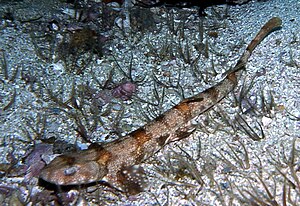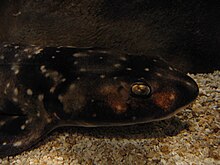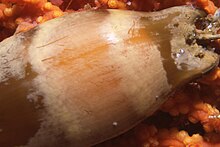Shy sharks
| Shy sharks | ||||||||||||
|---|---|---|---|---|---|---|---|---|---|---|---|---|

Puff adder dogfish ( H. edwardsii ) |
||||||||||||
| Systematics | ||||||||||||
|
||||||||||||
| Scientific name | ||||||||||||
| Haploblepharus | ||||||||||||
| Garman , 1913 |
The shy sharks ( Haploblepharus ) are a genus of the cat shark family (Scyliorhinidae) with four species. Their common name is derived from their behavior of curling up when threatened and covering their eyes with their tails. The genus is endemic to the marine area off the coast of South Africa , where they live in shallow water zones of the coastal area. All four species are small and have a stocky body with a broad, flattened head and a rounded snout. Very large nostrils with enlarged, triangular skin flaps that extend to the mouth are characteristic.
Blue sharks are bottom-dwelling hunters that feed on invertebrates ( crustaceans , sea worms ) and small bony fish . They lay eggs, with the females laying down large egg capsules. Due to their size, the sharks, which are harmless to humans, are generally not used by fishermen and disposed of as bycatch.
features

The species of shy sharks are very similar in their appearance, but can be safely differentiated based on morphological features. In their habitat, however, their different colors and patterns are the only ways to distinguish them from one another. However, this can vary greatly within the species, which makes it problematic to determine it in the field. All four species are very small and rarely grow longer than about 60 centimeters.
Sharks have a compressed, spindle-shaped body with a short head that is less than one-fifth of the total length. The basic color of the back is brown and, depending on the species, the animals have a pattern made up of darker saddle spots and white dots. The ventral side is white. The head is broad and dorsally flattened, the muzzle is rounded. The large, oval-shaped eyes have cat-like slit pupils , a rudimentary nictitating membrane and a prominent elevation below the eye. The nostrils are very large and each have a pair of genus-typical and strongly enlarged, triangular skin flaps that have grown together and extend to the mouth. A deep pit covered by them connects the outflow opening of the nostrils with the mouth, covered by the nasal lobes. The mouth opening is short and curved and has furrows in the corners of the mouth. The teeth have a central tooth tip and smaller secondary tips. The five pairs of gill slits are shifted to the top of the body.
The two dorsal fins start very far back on the body, with the first dorsal fin starting behind the attachment of the pelvic fin and the second dorsal fin behind the anal fin. The pectoral fins are broad and medium-sized, the dorsal, ventral and anal fins are about the same size. The short and broad caudal fin is about one-fifth the length of the body and has a deep notch near the tip of the upper lobe and a barely developed lower lobe. The skin is thick and covered by heavily calcified, leaf-shaped placoid scales.
distribution and habitat
All four species of shy sharks are endemic to the coastal waters of the southern tip of the African continent. Three species live exclusively in the coastal area of South Africa , while the dark dogfish can also be found in southern Namibia .
The sharks live on the ground and are found mainly in shallow coastal waters over sandy and stony ground.
Way of life
As generalist hunters, shy sharks feed on a wide variety of invertebrates, particularly crustaceans and sea worms , and small bony fish. They themselves are mainly preyed on by larger fish and marine mammals , especially seals . When threatened, the sharks roll their bodies into a ring and cover their eyes with their tails. It is believed that this way the sharks are more difficult to swallow for a potential attacker.
Sharks lay eggs ( oviparous ) and the females usually lay the eggs in pairs in the form of egg capsules with long fastening threads. Reproduction takes place throughout the year and there is no definable breeding season .
Evolution and systematics
The genus Haploblepharus was established in 1913 by the American zoologist Samuel Garman in the 36th edition of the Memoirs of the Museum of Comparative Zoology, at Harvard College to include the puff adder cat shark (previously described as Squalus edwardsii ). The name is derived from the Greek terms haplóos for "single" and blepharos for "eyelid".
In 1988 Leonard Compagno's shy sharks were classified on the basis of morphological characteristics together with the izak cat sharks ( Holohalaelurus ) and the tiger cat sharks ( Halaelurus ) in the tribe Halaelurini within the family of cat sharks (Scyliorhinidae).
| Halaelurini |
|
||||||||||||
|
|
Overall, the genus of the shy sharks comprises four described species:
- Puff adder dogfish ( Haploblepharus edwardsii (Schinz, 1822) )
- Brown dogfish ( Haploblepharus fuscus Smith, 1950 )
- Natal dogfish ( Haploblepharus kistnasamyi Human & Compagno, 2006 )
- Dark dogfish ( Haploblepharus pictus (Müller & Henle, 1838) )
The Natal dogfish ( Haploblepharus kistnasamyi ) was originally considered a local form of the puff adder dogfish and was only described as a separate species in 2006. A molecular biological investigation based on three genes of the mitochondrial DNA revealed that the puff adder dogfish is the most original species of its genus. The dark dogfish ( H. pictus ) and the brown dogfish ( H. fuscus ) are sister species according to this study; the natal dogfish was not considered in this study.
| Haploblepharus |
|
||||||||||||
|
|
Relationship with people
The species of the shy sharks are harmless to humans.
Because of their small size, the sharks for commercial fishing are not of interest, however, from bottom trawl fishermen and fishermen in the area of False Bay as bycatch caught and discarded. In addition, many of the sharks are caught by fishermen from the shore and also killed and disposed of. The sharks are used locally as bait for fishing for lobsters and are also caught as aquarium fish . The International Union for Conservation of Nature (IUCN) classifies two species of shy sharks as species on the warning list (Near Threatened), because although they are numerous within their range, this is very small and is located in a heavily fished area and thus one An increase in fisheries or a decrease in habitats could have a potentially large impact on total populations .
Web links
supporting documents
- ↑ Human, BA: Size-corrected shape variation analysis and quantitative species discrimination in a morphologically conservative catshark genus, Haploblepharus Garman, 1913 (Chondrichthyes: Carcharhiniformes: Scyliorhinidae) . In: African Natural History . 3, 2007, pp. 59-73.
- ^ Smith, JLB, MM Smith and PC Heemstra: Smiths' Sea Fishes . Struik, 2003, ISBN 1868728900 , pp. 91-92.
- ↑ a b c d e Compagno, LJV: Sharks of the World: An Annotated and Illustrated Catalog of Shark Species Known to Date . Food and Agricultural Organization, Rome 1984, ISBN 9251013845 , p. 332.
- ^ Dainty, AM (2002). Biology and ecology of four catshark species in the southwestern Cape, South Africa. M.Sc. thesis, University of Cape Town.
- ↑ Bester, C. Biological Profiles: Puffadder Shyshark . Florida Museum of Natural History Ichthyology Department. Retrieved August 31, 2009.
- ↑ Human, BA and Compagno, LJV: Description of Haploblepharus kistnasamyi , a new catshark (Chondrichthyes: Scyliorhinidae) from South Africa . In: Zootaxa . 1318, 2006, pp. 41-58. ( PDF )
- ↑ Human, BA, EP Owen, LJV Compagno and EH Harley: Testing morphologically based phylogenetic theories within the cartilaginous fishes with molecular data, with special reference to the catshark family (Chondrichthyes; Scyliorhinidae) and the interrelationships within them . In: Molecular Phylogenetics and Evolution . 39, No. 2, May 2006, pp. 384-391. doi : 10.1016 / j.ympev.2005.09.009 . PMID 16293425 .
- ↑ Van der Elst, R .: A Guide to the Common Sea Fishes of Southern Africa , third. Edition, Struik, 1993, ISBN 1868253945 , p. 71.
- ^ Fowler, SL, RD Cavanagh, M. Camhi, GH Burgess, GM Cailliet, SV Fordham, CA Simpfendorfer, and JA Musick: Sharks, Rays and Chimaeras: The Status of the Chondrichthyan Fishes . International Union for Conservation of Nature and Natural Resources, 2005, ISBN 2831707005 , pp. 265-266.
